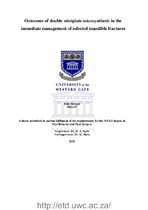| dc.contributor.advisor | Smit, Dirk | |
| dc.contributor.author | Dangor, Zain | |
| dc.date.accessioned | 2020-11-23T20:47:08Z | |
| dc.date.available | 2020-11-23T20:47:08Z | |
| dc.date.issued | 2020 | |
| dc.identifier.uri | http://hdl.handle.net/11394/7530 | |
| dc.description | >Magister Scientiae - MSc | en_US |
| dc.description.abstract | Introduction: A common complication of poorly managed mandible fractures is infection. There is a consensus amongst clinicians in treating infected mandible fractures in an immediate setting. The approach includes drainage of the purulent discharge, debridement of the fracture, removal of teeth in the fracture line and immediate fixation. Fixation can be load bearing or load sharing in nature. Although clinicians advocate for the use of a reconstruction load bearing plate, a double miniplate fixation could be an alternative.
Aim: The aim is to assess the outcomes of double miniplate osteosynthesis in the immediate management of infected mandible fractures Material and method: A prospective cohort study was conducted. The sample size was 20 (n =20). Infections were treated with an incision and drainage and the fractures fixated with a double miniplate fixation system. Pain scores, fracture union, fracture stability and surgical times were measured. Follow–up visits included one week, six weeks and three months respectively. | en_US |
| dc.language.iso | en | en_US |
| dc.publisher | University of the Western Cape | en_US |
| dc.subject | Infected | en_US |
| dc.subject | Sepsis | en_US |
| dc.subject | Mandible | en_US |
| dc.subject | Fracture | en_US |
| dc.subject | Fixation | en_US |
| dc.subject | Miniplate | en_US |
| dc.subject | Osteosynthesis | en_US |
| dc.title | Outcomes of double miniplate osteosynthesis in the immediate management of infected mandible fractures | en_US |
| dc.rights.holder | University of the Western Cape | en_US |

